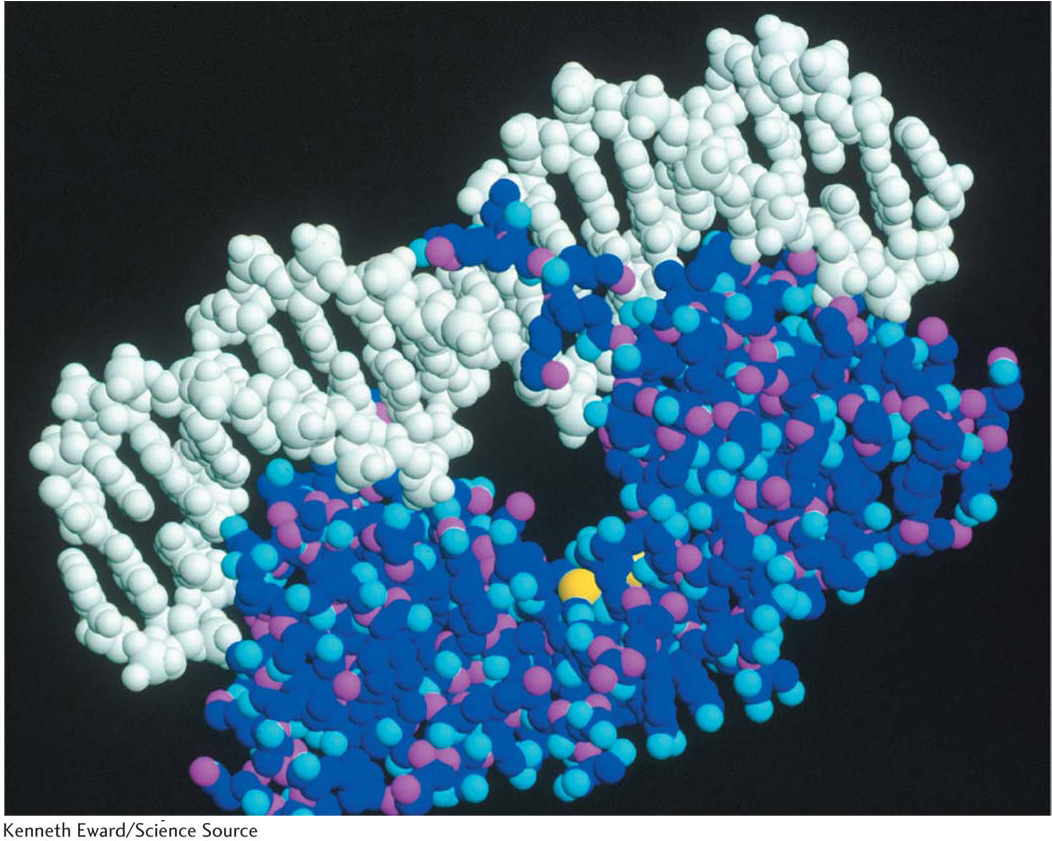Chapter Introduction
Regulation of Gene Expression in Bacteria and Their Viruses
397
Regulation of Gene
Expression in Bacteria
and Their Viruses
CHAPTER
11
LEARNING OUTCOMES
After completing this chapter, you will be able to
Contrast positive and negative regulation of gene expression, and explain how both mechanisms control the activity of the lac operon.
Identify the trans-
acting and cis- acting components of operons, and predict the effect of mutations in these components on gene expression. Compare how simple molecules trigger changes in gene expression of different operons in bacteria.
Explain the roles of sequence-
specific DNA- binding proteins and DNA regulatory sequences in coordinating the expression of sets of genes in bacteria and bacteriophage.

OUTLINE
|
11.1 |
Gene regulation |
|
11.2 |
Discovery of the lac system: negative control |
|
11.3 |
Catabolite repression of the lac operon: positive control |
|
11.4 |
Dual positive and negative control: the arabinose operon |
|
11.5 |
Metabolic pathways and additional levels of regulation: attenuation |
|
11.6 |
Bacteriophage life cycles: more regulators, complex operons |
|
11.7 |
Alternative sigma factors regulate large sets of genes |
398

In December 1965, the king of Sweden presented the Nobel Prize in Physiology or Medicine to François Jacob, Jacques Monod, and André Lwoff of the Pasteur Institute for their discoveries of how gene expression is regulated (Figure 11-1). The prizes were the fruit of an exceptional collaboration among three superb scientists. They were also triumphs over great odds. The chances were slim that each of these three men would have lived to see that day, let alone earn such honors.
Twenty-
Then came World War II.
As France was invaded and quickly defeated, Jacob raced for the coast to join the Free French forces assembling in England. He served as a medic in North Africa and in Normandy until badly wounded. Monod joined the French Resistance while continuing his work. After a Gestapo raid on his Sorbonne laboratory, Monod decided that working there was too dangerous (his predecessor in the Resistance was arrested and executed), and André Lwoff offered him space at the Pasteur. Monod, in turn, connected Lwoff with the Resistance.
After the liberation of Paris, Monod served in the French army and happened on an article by Oswald Avery and colleagues demonstrating that DNA is the hereditary material in bacteria (see Chapter 7). His interest in genetics was rekindled, and he rejoined Lwoff after the war. Meanwhile, Jacob’s injuries were too severe for him to pursue a career in surgery. Inspired by the enormous impact of antibiotics introduced late in the war, Jacob eventually decided to pursue scientific research. Jacob approached Lwoff several times for a position in his laboratory but was declined. He made one last try and caught Lwoff in a jovial mood. The senior scientist told Jacob, “You know, we have just found the induction of the prophage. Would you be interested in working on the phage?” Jacob had no idea what Lwoff was talking about. He stammered, “That’s just what I would like to do.”
The cast was set. What unfolded in the subsequent decade was one of the most creative and productive collaborations in the history of genetics, whose discoveries still reverberate throughout biology today.
One of the most important insights arrived not in the laboratory but in a movie theater. Struggling with a lecture that he had to prepare, Jacob opted instead to take his wife, Lise, to a Sunday matinee. Bored and daydreaming, Jacob drew a connection between the work he had been doing on the induction of prophage and that of Monod on the induction of enzyme synthesis. Jacob became “involved by a sudden excitement mixed with a vague pleasure…. Both experiments … on the phage … and that done with Pardee and Monod on the lactose system … are the same! Same situation. Same result … In both cases, a gene governs the formation … of a repressor blocking the expression of other genes and so preventing either the synthesis of the galactosidase or the multiplication of the virus…. Where can the repressor act to stop everything at once? The only simple answer … is on the DNA itself!” 1
And so was born the concept of a repressor acting on DNA to repress the induction of genes. It would take many years before the hypothesized repressors were isolated and characterized biochemically. The concepts worked out by Jacob and Monod and explained in this chapter—
399
Walter Gilbert, who isolated the first repressor and was later awarded a Nobel Prize in Chemistry for co-
The concepts that Jacob and Monod illuminated went far beyond bacterial enzymes and viruses. They understood, and were able to articulate with exceptional eloquence, how their discoveries about gene regulation pertained to the general mysteries of cell differentiation and embryonic development in animals. The two men once quipped, “anything found to be true of E. coli must also be true of Elephants.”3 In the next three chapters, we will see to what degree that assertion is true. We’ll start in this chapter with bacterial examples that illustrate key themes and mechanisms in the regulation of gene expression. We will largely focus on single regulatory proteins and the genetic “switches” on which they act. Then, in Chapter 12, we’ll tackle gene regulation in eukaryotic cells, which entails more complex biochemical and genetic machinery. And, finally, in Chapter 13, we’ll examine the role of gene regulation in the development of multicellular animals. There we will see how sets of regulatory proteins act on arrays of genetic switches to control gene expression in time and space and choreograph the building of bodies and body parts.